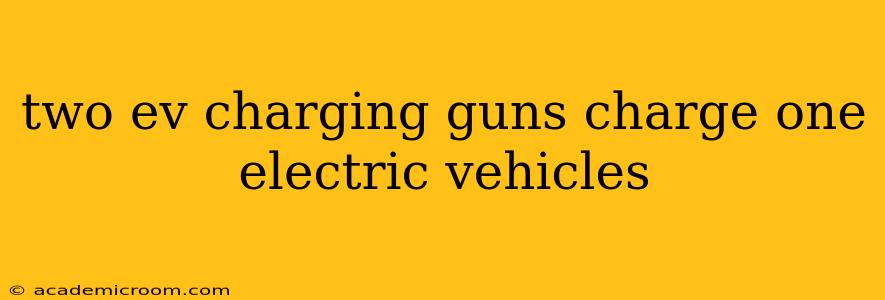Can Two EV Charging Guns Charge One Electric Vehicle?
The short answer is no, you can't use two EV charging guns simultaneously to charge a single electric vehicle. While the idea might seem appealing to speed up charging times, most EVs aren't designed to handle power from two chargers at once. This is primarily due to safety concerns and the limitations of the vehicle's onboard charging system.
Let's delve into the reasons why this isn't possible and explore some related questions.
Why can't I use two EV charging guns on one EV?
Electric vehicles have a built-in charging system that manages the power intake. This system is designed to accept a specific amount of power, depending on the vehicle's specifications and the charger's capabilities. Attempting to overload this system by connecting two chargers simultaneously could:
- Damage the vehicle's charging system: The influx of excessive power could fry sensitive components within the car's electrical system, leading to costly repairs or even rendering the vehicle inoperable.
- Create a fire hazard: Overloading the electrical system dramatically increases the risk of overheating and potentially causing a fire. Safety mechanisms are in place to prevent this, but adding a second charger bypasses these protections.
- Void the vehicle's warranty: Most manufacturers explicitly state in their warranty agreements that using unauthorized charging methods or overloading the charging system will void the warranty.
Essentially, the car's charging system acts as a gatekeeper, only accepting the amount of power it's designed to handle. Adding a second charger is like trying to force open the gate – the results are unpredictable and potentially disastrous.
What if I use two Level 1 chargers?
The same principles apply. Even with Level 1 chargers (which provide slower charging speeds using standard household outlets), connecting two simultaneously would still overload the vehicle's charging system and pose the same risks.
How can I charge my EV faster?
Instead of trying to use multiple charging guns, focus on using a higher-powered charger. The charging speed depends on several factors:
- Onboard charger: The vehicle's onboard charger determines the maximum charging rate it can accept.
- Charger type: Level 2 chargers offer significantly faster charging speeds than Level 1 chargers. DC fast chargers are the quickest but are less widely available.
- Battery state of charge: Charging slows down as the battery approaches full capacity.
- Battery temperature: Extreme temperatures can also affect charging speed.
To maximize your charging speed, utilize the highest-powered Level 2 charger available to your vehicle and charging infrastructure. Consider using a DC fast charger if you need a rapid top-up.
What are the different types of EV chargers?
There are primarily three types of EV chargers:
- Level 1: These use a standard household outlet and provide the slowest charging speed.
- Level 2: These use a dedicated 240-volt circuit (like a clothes dryer) and offer significantly faster charging.
- DC Fast Chargers: These provide the quickest charging speeds, but are less common and often require special connectors.
Understanding these differences is crucial in choosing the best charging method for your EV and lifestyle.
By understanding the limitations of EV charging systems and utilizing the appropriate charging methods, you can ensure the safe and efficient charging of your electric vehicle. Remember, safety should always be your top priority.
